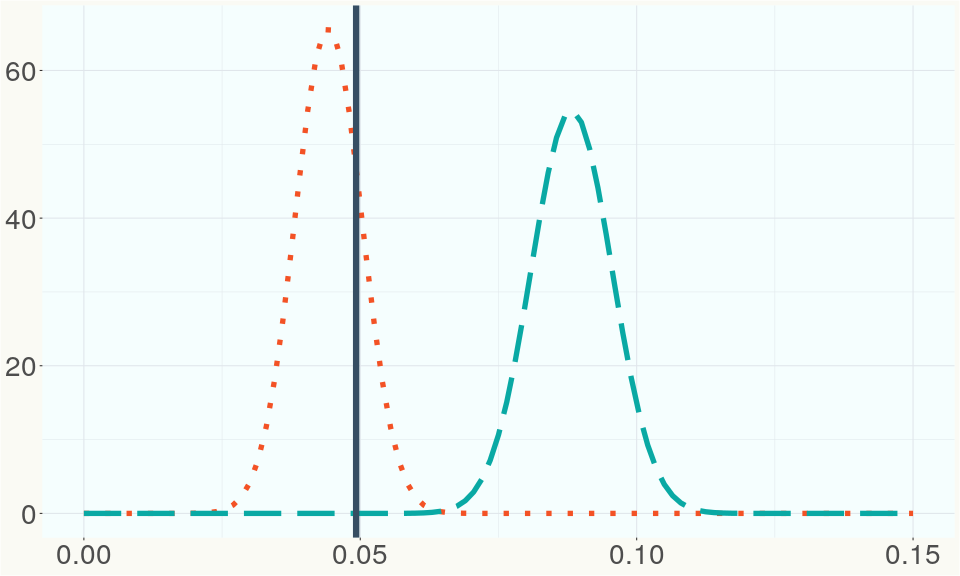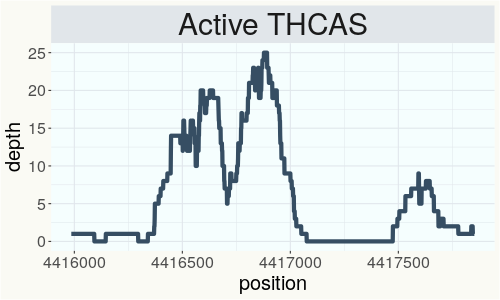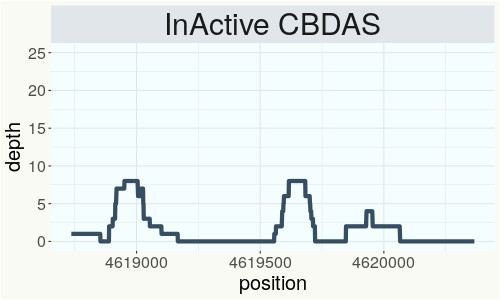Cheese
RSP 10460
Grower: CoffeShop 137
General Information
- Accession Date
- October 30, 2016
- Reported Plant Sex
- not reported
- Report Type
- StrainSEEK v2 3.2Mb
- DNA Extracted From
- Unknown
The strain rarity visualization shows how distant the strain is from the other cultivars in the Kannapedia database. The y-axis represents genetic distance, getting farther as you go up. The width of the visualization at any position along the y-axis shows how many strains there are in the database at that genetic distance. So, a common strain will have a more bottom-heavy shape, while uncommon and rare cultivars will have a visualization that is generally shifted towards the top.
Chemical Information
Cannabinoid and terpenoid information provided by the grower.
Cannabinoids
No information provided.
Terpenoids
No information provided.
Genetic Information
- Plant Type
- Type I
File Downloads
The bell curve in the heterozygosity visualization shows the distribution of heterozygosity levels for cannabis cultivars in the Kannapedia database. The green line shows where this particular strain fits within the distribution. Heterozygosity is associated with heterosis (aka hybrid vigor) but also leads to the production of more variable offspring. When plants have two genetically different parents, heterozygosity levels will be higher than if it has been inbred or backcrossed repeatedly.
The ratio of reads mapped to Y-contigs to reads mapped to the whole Cannabis genome (Y-ratios) has been demonstrated to be strongly correlated with plant sex typing. This plot shows the distribution of Y-ratios for all samples in our database which were sequenced with the same method (panel or WGS) as this sample and where this sample falls in the distribution.

This chart represents the Illumina sequence coverage over the Bt/Bd allele. These are the three regions in the cannabis genome that impact THCA, CBDA, CBGA production. Coverage over the Active CBDAS gene is highly correlated with Type II and Type III plants as described by Etienne de Meijer. Coverage over the THCA gene is highly correlated with Type I and Type II plants but is anti-correlated with Type III plants. Type I plants require coverage over the inactive CBDA loci and no coverage over the Active CBDA gene. Lack of coverage over the Active CBDA and Active THCA allele are presumed to be Type IV plants (CBGA dominant). While deletions of entire THCAS and CBDAS genes are the most common Bt:Bd alleles observed, it is possible to have plants with these genes where functional expression of the enzyme is disrupted by deactivating point mutations (Kojoma et al. 2006).



This chart represents the Illumina sequence coverage over the CBCA synthase gene.

Variants (THCAS, CBDAS, and CBCAS)
No variants to report
Variants (Select Genes of Interest)
| PKSG-2a | c.67T>A | p.Phe23Ile | missense variant | moderate | contig700 | 1945567 | A/T | |
| PKSG-2b | c.31A>T | p.Thr11Ser | missense variant | moderate | contig700 | 1951851 | T/A | |
| PKSG-4b | c.496A>G | p.Lys166Glu | missense variant | moderate | contig700 | 2721177 | T/C | |
| PKSG-4b | c.489delT | p.Phe163fs | frameshift variant | high | contig700 | 2721183 | CA/C | |
| aPT1 | c.406A>G | p.Ile136Val | missense variant | moderate | contig121 | 2839605 | A/G |
Nearest genetic relatives (All Samples)
- 0.036 RKM-2018-003 (RSP11094)
- 0.152 Black Jack (RSP10603)
- 0.153 Northern Lights (RSP11501)
- 0.155 BLACK JACK (RSP11346)
- 0.163 RKM-2018-025 (RSP11117)
- 0.165 RKM-2018-016 (RSP11108)
- 0.167 Serious Happiness (RSP10763)
- 0.168 Durban Poison #1 (RSP10996)
- 0.172 Blue Dream (RSP11010)
- 0.175 RKM-2018-020 (RSP11112)
- 0.179 Electra (RSP11366)
- 0.181 Domnesia (RSP11184)
- 0.182 Durban Poison #1 (RSP11013)
- 0.184 Doug s Varin (RSP11243)
- 0.186 RKM-2018-027 (RSP11119)
- 0.187 RKM-2018-030 (RSP11122)
- 0.187 Top 44 (SRR14708268)
- 0.188 Saint Jack (RSP11179)
- 0.188 Blue Dream (RSP11004)
- 0.188 Super Blue Dream (RSP11011)
Most genetically distant strains (All Samples)
- 0.420 Cherry Blossom (RSP11323)
- 0.409 Feral (RSP11205)
- 0.408 80E (RSP11213)
- 0.398 Cherry Blossom (RSP11314)
- 0.394 Cherry Blossom (RSP11317)
- 0.392 CS (RSP11208)
- 0.390 Cherry Blossom (RSP11298)
- 0.390 Cherry Blossom (RSP11311)
- 0.389 Cherry Blossom (RSP11328)
- 0.389 Feral (RSP11206)
- 0.387 Carmaleonte (RSP11207)
- 0.386 Feral (RSP10892)
- 0.385 80E (RSP11211)
- 0.385 R1in136 (SRR14708227)
- 0.384 R3in134 (SRR14708218)
- 0.383 Cherry Blossom (RSP11333)
- 0.381 Feral (RSP10891)
- 0.380 R1in136 (SRR14708226)
- 0.380 XBL1 (SRR14708207)
- 0.379 Feral (RSP10890)
Nearest genetic relative in Phylos dataset
- Overlapping SNPs:
- 72
- Concordance:
- 70
Nearest genetic relative in Lynch dataset
- Overlapping SNPs:
- 7
- Concordance:
- 7
Blockchain Registration Information
- Transaction ID
-
2820ae77d6a189c4
13a95c5065b47352 deae6e1ab0ff9618 c945a22800703dde - Stamping Certificate
- Download PDF (862.8 KB)
- SHASUM Hash
-
5f79636e25d08064ac7abe8f9ec01259 385e693fa2991427 9d3a9c8274f3a4c6